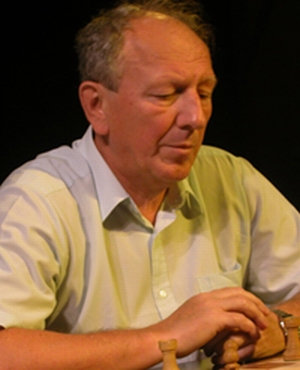First-move advantage facts for kids
The first-move advantage in chess means that the player who moves first, White, has a small edge in the game. This has been seen in millions of chess games recorded since 1851. In almost all types of chess games, White tends to win more often than Black.
To figure out White's total winning score, we add the percentage of games White won to half the percentage of games that ended in a draw. For example, if White wins 40 out of 100 games, draws 32, and loses 28, White's total score is 40 plus half of 32 (which is 16), making it 56 percent. This advantage is true for both human players in chess tournaments and even for computers playing against each other. However, White's advantage is smaller in fast-paced games or when beginners play.
Since the late 1800s, many chess experts, including World Champion Wilhelm Steinitz, have believed that if both players played perfectly, the game would end in a draw.
Contents
Does White Really Win More Often?
Yes, statistics show that White generally scores better. Recent studies suggest White wins about 54% to 56% of games. This means White wins slightly more than half the games played.
| White wins |
Drawn | Black wins |
Total score for White |
|
|---|---|---|---|---|
| Tournaments 1851–1878 |
45.52% | 14.07% | 40.41% | 52.55% |
| Tournaments 1881–1914 |
36.89% | 31.76% | 31.35% | 52.77% |
| Tournaments 1919–1932 |
36.98% | 36.98% | 26.04% | 55.47% |
| Tournaments overall 1851–1932 |
38.12% | 30.56% | 31.31% | 53.40% |
| New in Chess database 2000 |
N/A | N/A | N/A | 54.8% |
| ChessGames.com database 2008 |
36.81% | 36.50% | 26.69% | 55.06% |
| World Blitz Chess Championship 2009 |
38.96% | 26.41% | 34.63% | 52.16% |
| CEGT chess engines results (40/120) 2009 |
34.7% | 41.3% | 24.0% | 55.4% |
For most of the 20th century, White's winning percentage was around 56%. More recently, it has dropped slightly to about 55%. Websites like ChessGames.com keep track of millions of games. In 2008, their database showed White winning 36.81% of games, 36.50% were draws, and Black won 26.69%. This adds up to White having a 55.06% overall score.
The "New In Chess" database in 2000 found that White scored 54.8% across over 730,000 games. When looking at specific opening moves, White scored 54.1% after 1.e4 and 56.1% after 1.d4. One reason 1.e4 was less effective is the Sicilian defence (1.e4 c5), where White only scored 52.3%.
Even computer chess engines show this advantage. In tests where strong chess engines play each other, White consistently scores around 54% to 55%, even at different game speeds.
Why a Draw is Expected with Perfect Play
In 1735, Joseph Bertin wrote that the player who moves first has the "attack." This means White starts with the initiative and tries to keep it. Black's goal is usually to stop White's attack and make the game equal. Because White starts with an advantage, a small mistake by White might just lose the initiative. But a similar mistake by Black could lead to bigger problems.
Chess master Evgeny Sveshnikov said in 1994 that Black players "cannot afford to make even the slightest mistake." He believed White should play to win, while Black should play for a draw.
Most chess experts agree that if both players made the best possible moves every time, the game would end in a draw. Even though this can't be proven, it's a widely accepted idea among strong players. World Champion Bobby Fischer also thought this was true.
Black's Dynamic Play
Modern chess players often think of Black's role as more than just trying to make the game equal. Some experts believe that Black doesn't always need to "equalize" but can instead look for active ways to create chances.
Bobby Fischer once shared his "secret": he tried to win with the black pieces from the very beginning. He felt that realizing Black could have active chances, instead of just aiming for a draw, was a turning point in his career.
Grandmasters like Garry Kasparov, when playing Black, focus on the specific situation on the board. They try to take the initiative whenever they can. This style of play, where Black looks for active and complex positions, has become very popular. Sometimes, a position is so complicated that it's not about being "equal," but about being "dynamically balanced," meaning either player could gain an advantage.
Modern chess thinkers also question if White's first-move advantage lasts forever. They suggest that sometimes the player with the initiative can lose it without a clear reason. If a player tries too hard to keep the initiative, they might use up their energy and be unable to handle a strong counter-attack from the opponent. This means that sometimes, when White's initial advantage fades, Black might actually gain an advantage instead of just reaching equality.
Fair Play in Tournaments
In chess tournaments and matches, it's important that players get a fair chance to play as both White and Black.
- In matches, the player who gets White in the first game is chosen randomly. After that, the colors switch each game.
- In "round robin" tournaments, where everyone plays everyone else, players usually get an equal number of games as White and Black. This helps make sure the final standings are fair.
- In "Swiss system" tournaments, the tournament director tries to make sure each player gets about the same number of games with White and Black. They also try to make sure the colors alternate from one round to the next.


